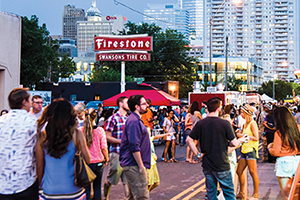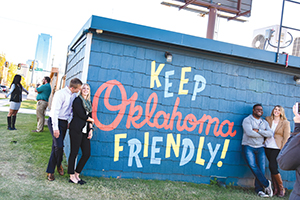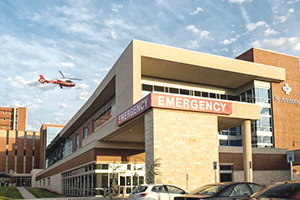By JULIE MINDA
St. Anthony Hospital of Oklahoma City has completed a 12-year, $220 million campus renovation and expansion that spurred economic recovery in the facility's formerly depressed downtown community. "We revitalized a dying hospital and helped revitalize a neighborhood," said Joe Hodges, regional president of hospital operations for SSM Health of Oklahoma, which is the regional parent of the hospital.

Hodges
The project added a pavilion with an emergency department, two intensive care units and a progressive care unit; improved patient care areas; and redesigned an entrance. The expansion increased St. Anthony's bed count by 72, to 774. The construction also included a new medical office building, rehabilitation unit and surgery center on the campus. As it was making the physical changes, St. Anthony also was enhancing patient care and improving morale, according to Hodges.
SSM motivated civic and private investment in the Midtown Oklahoma City neighborhood where the hospital is located, said Meg Salyer, a St. Anthony board member, city councilwoman and owner of a business near Midtown. "The neighborhood made a 180 degree transformation." Before the redevelopment, "There were prostitutes and drug dealers" working nearby streets, Salyer said. "St. Anthony's customers were afraid to come" to the hospital.
But that changed, Salyer said, because St. Anthony "became a hospital of choice, and that attracted private money" to the community.
Hard choice
In the 1990s in the Midtown community, which is several city blocks northwest of central Oklahoma City, conditions were depressed. "There were dilapidated buildings all around us," said Hodges. "There was plywood over windows and overgrown grass," added Salyer.

Salyer
Hodges said that numerous St. Anthony physicians were being recruited to suburban facilities; and focus group research revealed that people thought of St. Anthony, with its outdated veneer, as "old, tired and Catholic." Hodges said, "We could change the old and tired — not the Catholic," because the hospital's Catholicity is integral to its identity.
St. Anthony faced a choice: to move to the suburbs — it had an option on a property in a growing, affluent suburban area — or to commit to staying and serving as an anchor for the urban core, and playing a role in revitalizing the neighborhood, said Hodges.
St. Anthony leaders committed around 2003 to stay and to invest in the Midtown hospital and community.
Salyer said, "You need to recognize just how difficult of a decision it was. The really easy choice would be to go to the suburbs and have a magnificent new facility. But, St. Anthony chose the hard decision, to stay in the urban environment where the hospital was sorely needed.
"They chose to use their money to leverage additional investment and literally changed the face of Oklahoma City," said Salyer. "It took a lot of courage."

Crowds enjoy the "H&8th Night Market," Oklahoma City's largest gathering of food trucks. The event, which happens each June in Midtown, features more than 40 food trucks, live music and shopping. It attracts about 40,000 people.
Photo by: Oklahoma City Convention & Visitors Bureau
Building momentum
Hodges said, "We didn't do it in a vacuum; we attracted the right people to invest in the city. We reached out to city leaders to get a cause of action, to help change an entire part of Oklahoma City."
St. Anthony purchased dilapidated properties, razed unsightly buildings and made the land attractive to private investors. Over the past decade developers have built a hotel, apartments, condos and houses; restaurants, pubs and wine bars have opened in Midtown.
"It's now one of the hippest retail areas," said Hodges. "The area is attracting a younger crowd that likes to walk to restaurants."
The city built roundabouts and made roadway improvements to improve traffic flow. It installed public art projects.
Culture change
As the hospital campus renovation progressed — with technologically advanced facilities coming online — its leaders also implemented new patient quality efforts. Clinicians focused on improving the facility's quality core measures for heart attack care, congestive heart failure care, pneumonia care and surgical care infection prevention and have achieved top performer levels in all of those areas from the Joint Commission over the past decade, according to hospital spokesperson Sandra Payne.

Visitors gather at Bleu Garten, Midtown's outdoor food truck park.
Photo by: Oklahoma City Convention & Visitors Bureau
St. Anthony also made changes aimed at building job satisfaction. For instance, the hospital now uses the occasional humorous video to communicate information to employees. It hosted "Java with Joe" conversations with Hodges when he was hospital head and now hosts "Talk with Tammy" conversations with current St. Anthony President Tammy Powell. Its July 4 picnic has contests, music and fun activities for employees. Its annual "Mission Day" boasts nationally recognized speakers and includes reflection time and acknowledgement for exceptional employees.
The pavilion St. Anthony opened on June 22 completes the decade-plus of work. Hodges said the capstone project was like a "thank you" to the staff and physicians.
He said the investments are paying off. St. Anthony now is the fastest growing hospital in Oklahoma by inpatient admissions; employee satisfaction has improved; the hospital has seen significant growth in its surgery program; it's having no problem recruiting physicians; and it has a low nurse vacancy rate.
Hodges said, "A core mission of ours is to help change the community," and this revitalization helped St. Anthony do that.
Prospects of Oklahoma City and SSM Health hospital are closely intertwined The fortunes of St. Anthony Hospital long have been interconnected with those of its Midtown community in Oklahoma City. Two Sisters of St. Francis founded the hospital in 1898 because the newly established Oklahoma Territory had no hospital, and "its citizens were dying from lack of care," according to information from St. Anthony. As the city grew, the congregation expanded its health care ministry. In the late 1980s, the sisters combined their ministry with the Sisters of St. Mary to form the Franciscan Sisters of Mary. In the late 1980s, St. Anthony joined what is now SSM Health, based in St. Louis. Meg Salyer, a St. Anthony board member, city councilwoman and owner of a business near St. Anthony, said in the 1980s Oklahoma City was in decline. An oil bust and a bank failure at the start of the decade hurt downtown businesses and caused significant job loss. Oklahoma City's Penn Square Bank failed, causing major losses locally and with financial institutions nationwide, Salyer said. At the same time, families were moving to the suburbs chasing the prospect of better schools, amenities and work. Salyer said, "The city's inner core was decimated. But, the downtown should be your heartbeat." She said in the early 1990s, Oklahoma City was among the cities competing to be the location for a United Airlines aircraft manufacturing facility. Voters passed a measure to use tax funding to build the facility. But Oklahoma City lost out anyway after the airline sent "secret shoppers" — executives and their spouses — to tour the cities contending for the bid. "They said they couldn't imagine sending their executive team here. There was low quality of life," Salyer said. City leaders used the experience in 1993 to convince the public to vote for a different tax plan for funds for a citywide improvement effort. Over time that effort included the development of an urban canal, a new library, improvement to the state fairgrounds, the creation of a waterway that later would be used as an Olympic training site, the construction of a sports arena, improvements to a civic center, a Triple A league ballpark and a historic trolley network, with most of the civic projects in downtown Oklahoma City, several city blocks from Midtown. "It was hugely successful," Salyer said of the improvement effort.  The emergency department at St. Anthony's Hospital in Oklahoma City is part of the hospital's recently completed $220 million expansion and revitalization project. In the middle of that improvement project came the April 1995 bombing of Oklahoma City's Alfred P. Murrah Federal Building, which is less than a mile southeast of St. Anthony. One hundred sixty-eight people were killed in the blast; hundreds of buildings were damaged or destroyed. Salyer said, "That bombing inspired a paradigm shift. We said, 'We won't let a terrorist tear us apart.'" Joe Hodges agreed. As a city, "we said, 'We need to continue to revitalize.'" Hodges is regional president of hospital operations for SSM Health of Oklahoma. Despite the enthusiasm for change, and continued civic and private investment in Oklahoma City after the bombing, the progress did not touch all areas of the city, and by the turn of the millennium the Midtown area had not recovered from the years of decline. It was in this context that St. Anthony and SSM leaders weighed a move to the suburbs, but decided to stay and double down on the commitment to downtown Oklahoma City. |